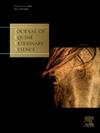Characterization of the germplasm bank for the Spanish autochthonous breed Asturcon
IF 1.3
3区 农林科学
Q2 VETERINARY SCIENCES
引用次数: 0
Abstract
Germplasm banks provide an essential service by safeguarding the genetics of endangered or valuable species or individuals and are one of the strategies to preserve endangered domestic breeds (Solti et al. Theriogenology 2000; 53, 149-162). The SERIDA (Asturias, Spain) keeps germplasm from several local breeds. The aim of this work is to characterize the semen of Asturcon ponies, an autochthonous and endangered equine breed adapted to the mountainous Atlantic environment and officially protected (National Official Breed Catalog). The study included 241 ejaculates from 16 pony stallions (aged 6-17 years) collected by artificial vagina, 3 days per week, in breeding season (from April to July) over 5 years (Crespo et al. Animal Reproduction Science 2020; 223,106641). Immediately after collection, gel-free semen was evaluated for: volume, estimated from a graduated tube; sperm concentration, determined with a calibrated spectrophotometer (Accucell, IMV Technologies, L'Aigle, France); and motility, assessed subjectively with a phase contrast microscope (× 4 objective) and heated stage (37°C) and by Computer-Assisted Sperm Analysis (CASA) system (ISAS v. 1.19 software; Proiser, Spain) in fresh and post-thawed semen. Then semen was diluted and centrifuged for 12 min at 600 g, the supernatant was discarded, and the pellet was resuspended in freezing medium (skim milk extender with 2% egg yolk and 2.5% glycerol), to a final concentration of 100 × 106 spermatozoa/ml, and equilibrated/cooled (60 min) to 4°C (Fayrer-Hosken et al. Journal of Equine Veterinary Science 2008; 28, 672-676). Semen doses were packaged in 0.50 mL straws, frozen in a programmable freezer (Digit-cool; IMV Technologies) with a two-steps curve and stored in liquid nitrogen in SERIDA cryobank. Three straws per ejaculate were thawed in a water bath at 37°C for 30 s and pooled before analyses. Statistical analysis was carried out by means of the GLM and CORR procedures and Duncan test for means (SAS Institute, Inc., Cary, NC, USA). A significant effect between males (P < 0.05) on semen quality, such as volumen, sperm concentration and motility, were detected. On the other hand, positive and significant correlations (r=0.76; P < 0.05) were found between sperm motility pre-freezing and post-thawed (total motility 26–43%, progressive 14–28%). It is well known that there are considerable differences between stallions in the success of spermatozoa to survive cryopreservation, and often among ejaculates as well (AI-Kass and Morrell. Veterinary Science 2024; 11, 65). Whereas the sperm parameters of this endangered breed are acceptable, future research should focus on optimizing the existing protocols and on the ability of Asturcon stallions’ sperm to survive freezing and thawing procedures in rates higher than 35% to ensure that germplasm bank are correctly created.
求助全文
约1分钟内获得全文
求助全文
来源期刊

Journal of Equine Veterinary Science
农林科学-兽医学
CiteScore
2.70
自引率
7.70%
发文量
249
审稿时长
77 days
期刊介绍:
Journal of Equine Veterinary Science (JEVS) is an international publication designed for the practicing equine veterinarian, equine researcher, and other equine health care specialist. Published monthly, each issue of JEVS includes original research, reviews, case reports, short communications, and clinical techniques from leaders in the equine veterinary field, covering such topics as laminitis, reproduction, infectious disease, parasitology, behavior, podology, internal medicine, surgery and nutrition.
 求助内容:
求助内容: 应助结果提醒方式:
应助结果提醒方式:


